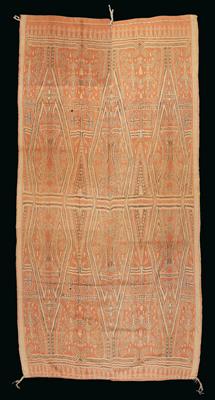Indonesia, Borneo (Kalimantan, Sarawak), Dayak: a large Dayak ceremonial cloth, called a ‘pua’. With figural decoration. Dyed using the Ikat technique.
Indonesia, Borneo (Kalimantan, Sarawak), Dayak: a large Dayak ceremonial cloth, called a ‘pua’. With figural decoration. Dyed using the Ikat technique.

Pure ritual cloths, known as ‘pua’, play an important role in the life of the people of Borneo. The Dayak attributed ‘magic powers’ to ‘pua cloths’, which became effective in rituals. During initiations, weddings and other important ceremonies, the main protagonists were cloaked in ‘pua’. ‘Holy shrines’ in the longhouses of the Dayak would be covered in ‘pua’ cloths. And, during rice-sowing and harvest festivals, sacrificial offerings were also wrapped in ‘pua’ as a welcome gift to the gods. For similar reasons, the dead were wrapped in ‘Pua’ cloths at their burial, so that they might be benevolently received in the afterlife, in the realm of the ancestors.
The present old ‘pua’ ritual cloth is probably from the subgroup of the Iban Dayak. It consists of two woven swathes of light-coloured cotton, sewn together in the middle and dyed with red and dark brown natural dyes (plant dyes) using the Ikat technique. With this Ikat technique of dyeing, the warp threads are bound off at the correct locations prior to weaving and dyed. That means that the weaver must know exactly where she wants to bind the warp threads off before she dyes them to ensure that the pattern she has planned appears after she has woven them.
The present Dayak pua depicts a large lozenge motif (probably abstract ‘snakes’) reflected in a diagonal axis, as well as a row of six ‘warriors’ with helmets and armours on both sides. In between, there are many smaller images that are hard to make out (‘snakes’, objects etc.). The finishing on both sides creates jagged rows of the tumpal motif, very popular in Indonesia, which originates from the Dongson culture (800 BCE to 200 CE).
Overall, this is a typical, unusually old piece of its kind, visibly somewhat faded due to protracted display in sunlight. No significant damage.
Dimensions: 272 cm x 113 cm. Between c. 1900 and the first third of the 20th century. (ME)
Provenance: Austrian private collection.
Lit.: ‘Traditional Indonesian Textiles’ von John Gillow, Abb. 17, 84, 85; ‘Iban Art’ von M. Heppell, L. A. Melaka, E. A. Usen, Abb. 22, 23, 24, 27, 47, 48, 61, 64 u. a.
Expert: Prof. Erwin Melchardt
 Prof. Erwin Melchardt
Prof. Erwin Melchardt
+43-1-515 60-465
erwin.melchardt@dorotheum.at
06.04.2017 - 15:00
- Vyvolávací cena:
-
EUR 500,-
Indonesia, Borneo (Kalimantan, Sarawak), Dayak: a large Dayak ceremonial cloth, called a ‘pua’. With figural decoration. Dyed using the Ikat technique.
Pure ritual cloths, known as ‘pua’, play an important role in the life of the people of Borneo. The Dayak attributed ‘magic powers’ to ‘pua cloths’, which became effective in rituals. During initiations, weddings and other important ceremonies, the main protagonists were cloaked in ‘pua’. ‘Holy shrines’ in the longhouses of the Dayak would be covered in ‘pua’ cloths. And, during rice-sowing and harvest festivals, sacrificial offerings were also wrapped in ‘pua’ as a welcome gift to the gods. For similar reasons, the dead were wrapped in ‘Pua’ cloths at their burial, so that they might be benevolently received in the afterlife, in the realm of the ancestors.
The present old ‘pua’ ritual cloth is probably from the subgroup of the Iban Dayak. It consists of two woven swathes of light-coloured cotton, sewn together in the middle and dyed with red and dark brown natural dyes (plant dyes) using the Ikat technique. With this Ikat technique of dyeing, the warp threads are bound off at the correct locations prior to weaving and dyed. That means that the weaver must know exactly where she wants to bind the warp threads off before she dyes them to ensure that the pattern she has planned appears after she has woven them.
The present Dayak pua depicts a large lozenge motif (probably abstract ‘snakes’) reflected in a diagonal axis, as well as a row of six ‘warriors’ with helmets and armours on both sides. In between, there are many smaller images that are hard to make out (‘snakes’, objects etc.). The finishing on both sides creates jagged rows of the tumpal motif, very popular in Indonesia, which originates from the Dongson culture (800 BCE to 200 CE).
Overall, this is a typical, unusually old piece of its kind, visibly somewhat faded due to protracted display in sunlight. No significant damage.
Dimensions: 272 cm x 113 cm. Between c. 1900 and the first third of the 20th century. (ME)
Provenance: Austrian private collection.
Lit.: ‘Traditional Indonesian Textiles’ von John Gillow, Abb. 17, 84, 85; ‘Iban Art’ von M. Heppell, L. A. Melaka, E. A. Usen, Abb. 22, 23, 24, 27, 47, 48, 61, 64 u. a.
Expert: Prof. Erwin Melchardt
 Prof. Erwin Melchardt
Prof. Erwin Melchardt
+43-1-515 60-465
erwin.melchardt@dorotheum.at
|
Horká linka kupujících
Po-Pá: 10.00 - 17.00
kundendienst@dorotheum.at +43 1 515 60 200 |
| Aukce: | Mimoevropské a domorodé umění |
| Typ aukce: | Salónní aukce |
| Datum: | 06.04.2017 - 15:00 |
| Místo konání aukce: | Wien | Palais Dorotheum |
| Prohlídka: | 01.04. - 06.04.2017 |
